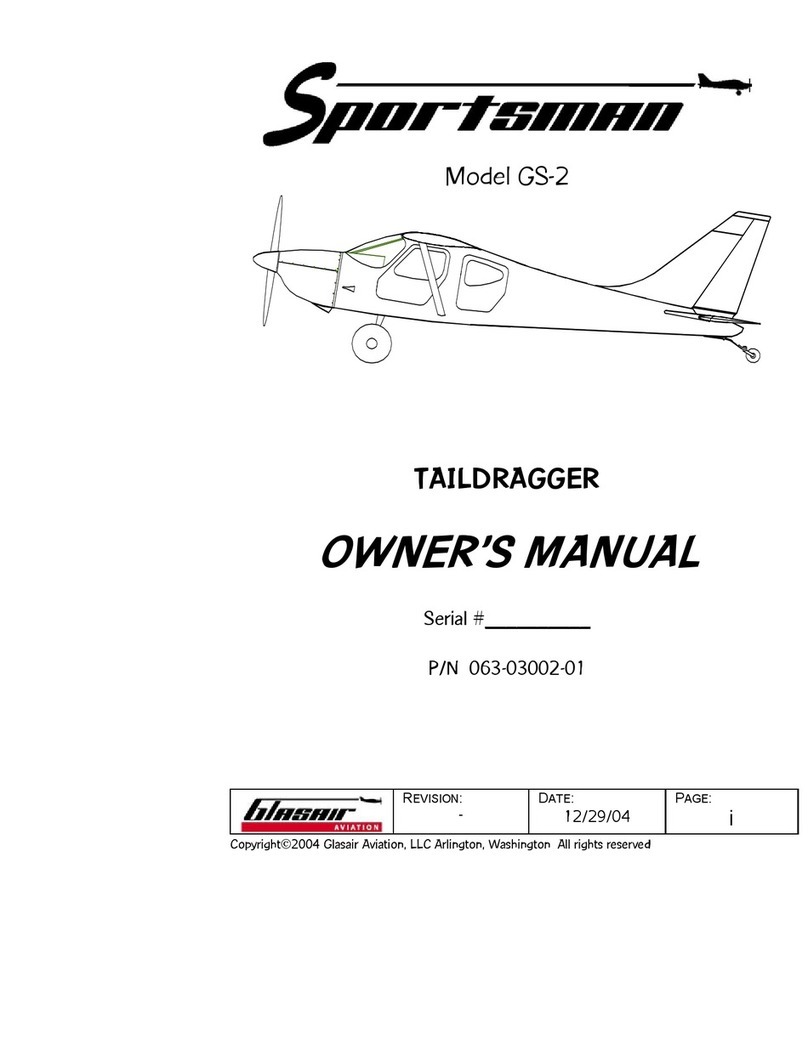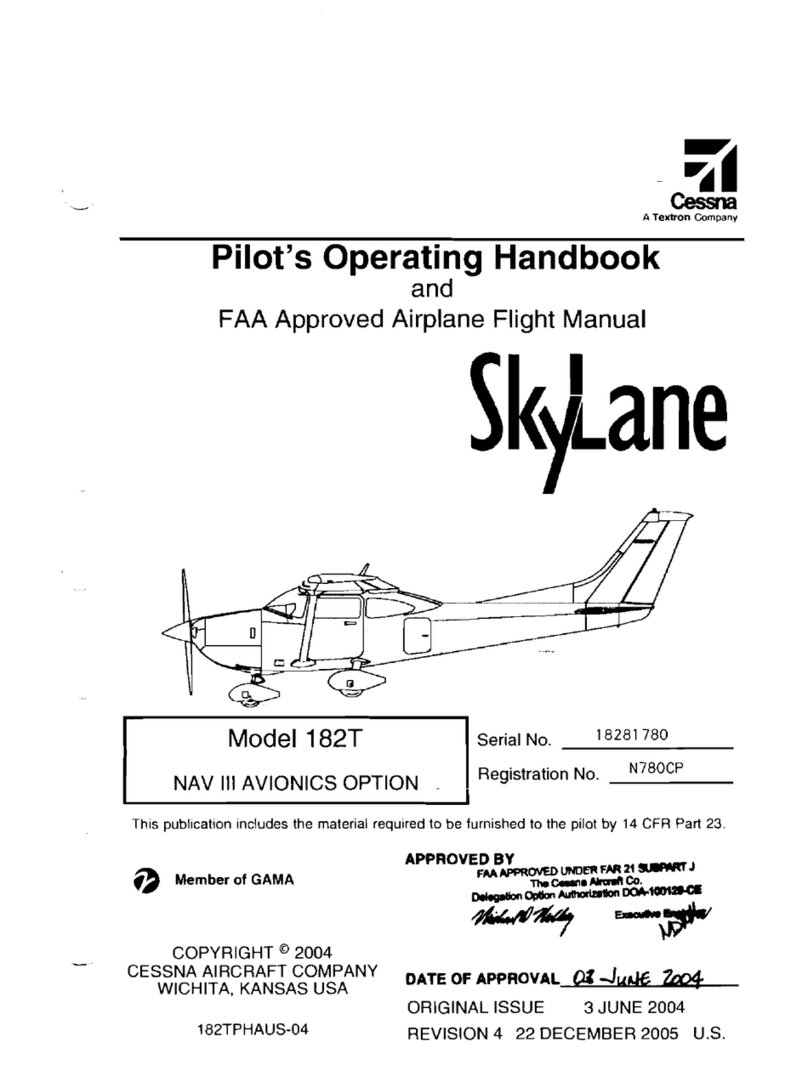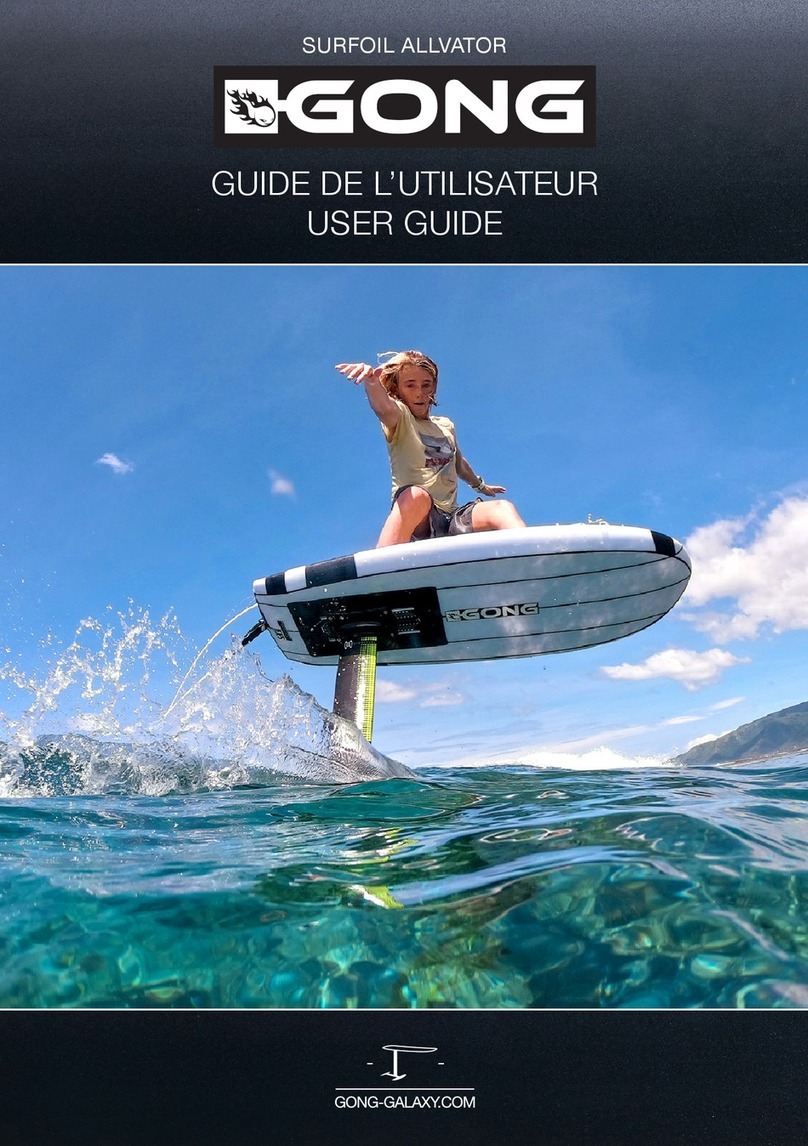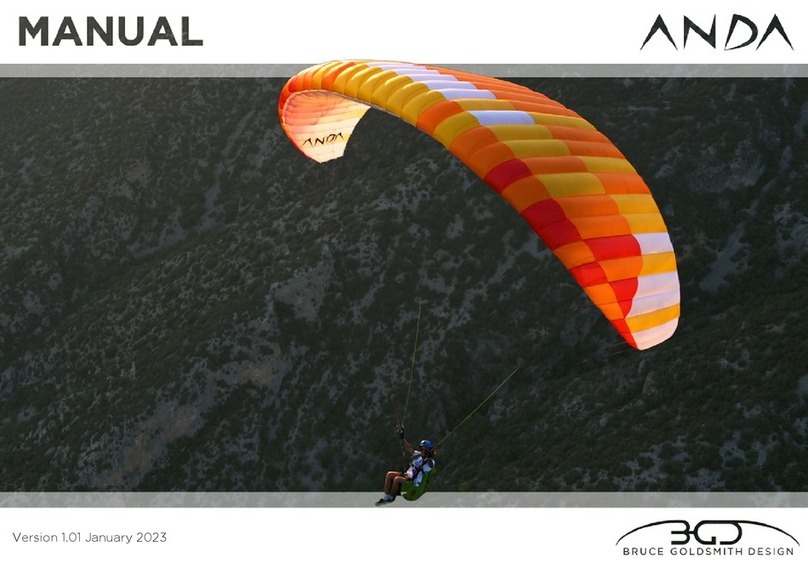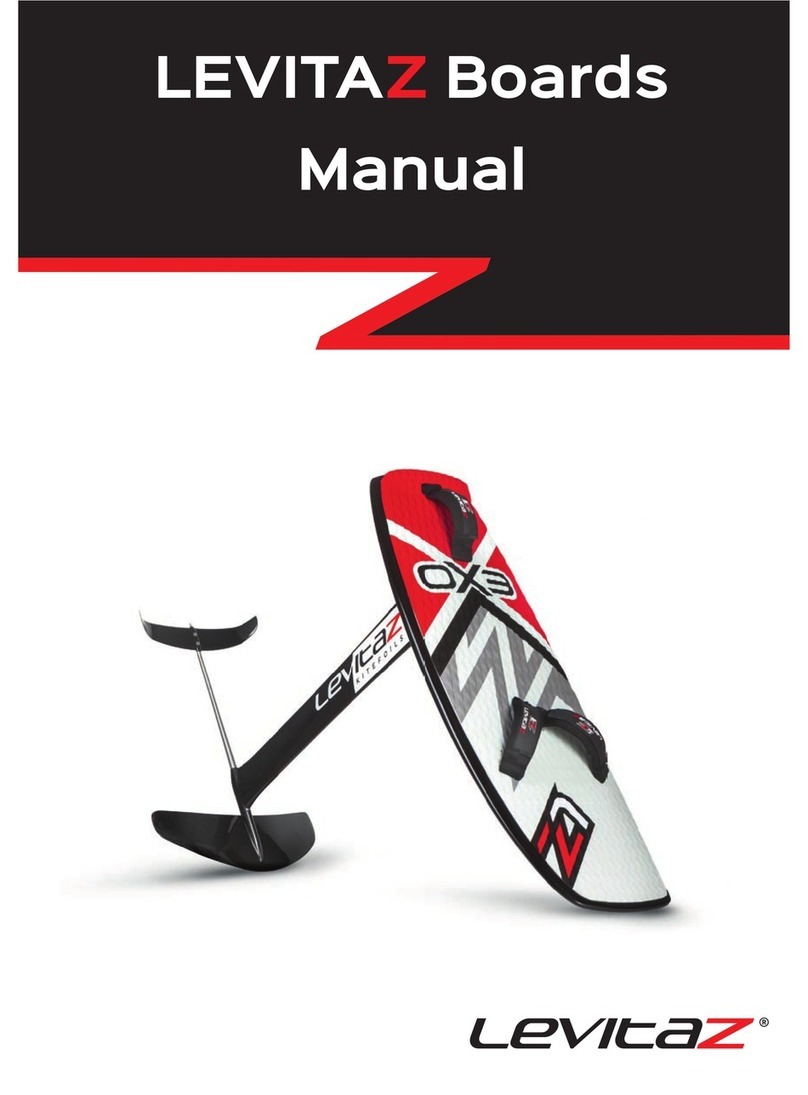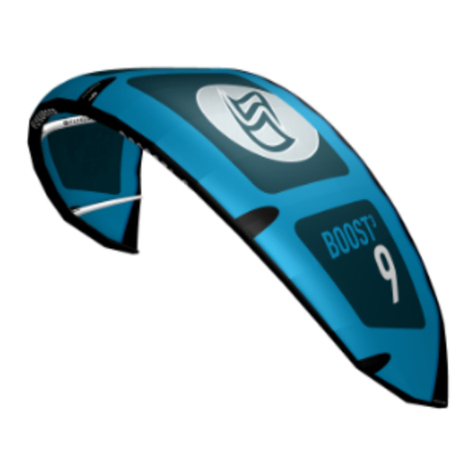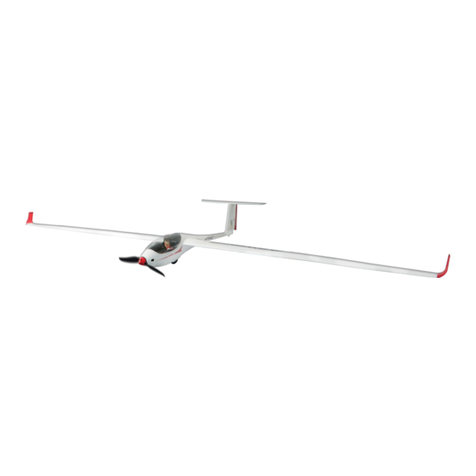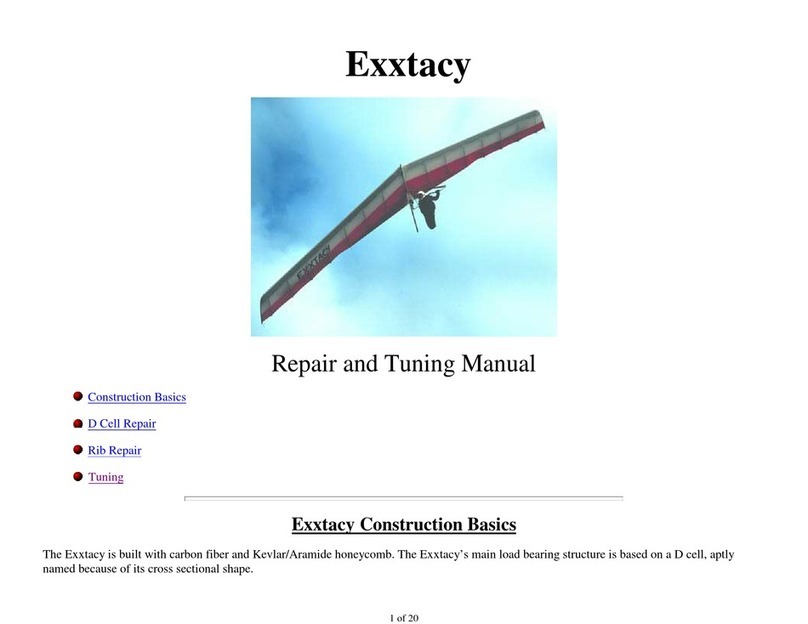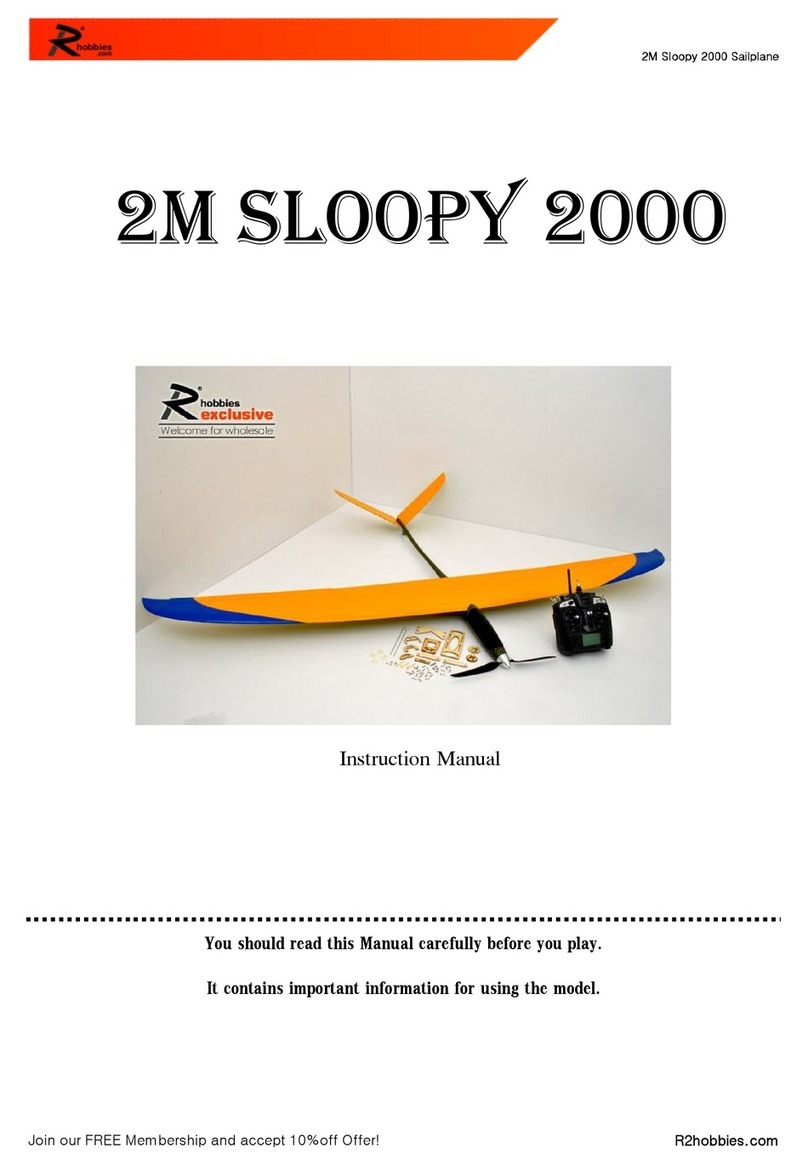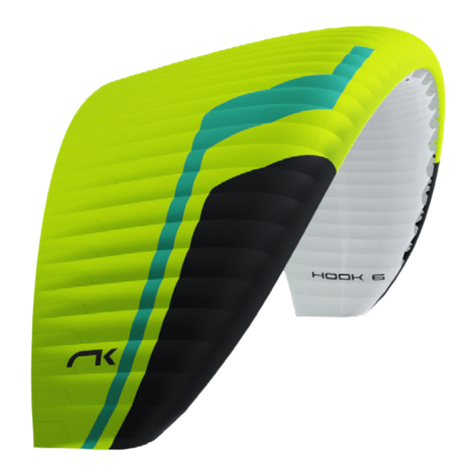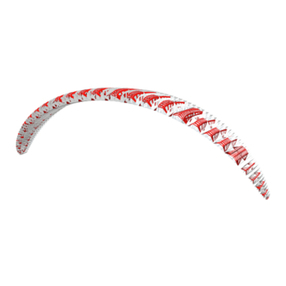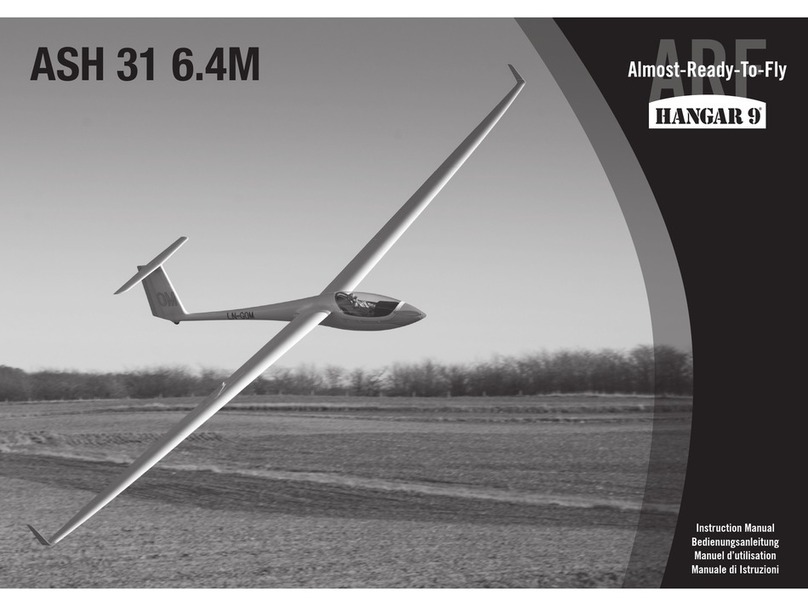Flusurfer Speed 3 User manual

USER MANUAL

Faire du kite-surf est dangereux
Le kitesurf est un sport dangereux, qui présente
des risques pour les sportifs et de même pour
d’autres personnes. La mauvaise utilisation du
kite peut causer de graves blessures et même
la mort de l’utilisateur et d‘ autres personnes!
Responsabilité
En utilisant le kite, l’utilisateur porte son entière
responsabilité de soi-même et des autres
personnes. Avant l’usage de ce kite, chaque
utilisateur doit avoir effectué une formation qua-
lifiée. Le mode d’emploi ci- inclus (manuel) est
également disponible en téléchargement sur le
site web www.flysurfer.com.
Ne pas voler avec le kite
Il ne faut absolument pas utiliser ce kite pour
voler. Il n’est ni examiné ni autorisé comme
engin volant. Le kite ne remplit pas les condi-
tions de fermeté posées à des engins volants
(comme p.ex. le
parapente). L’usage comme engin volant est
illégal et n’est pas legitimisé par la législation
aérienne et la législation des assurances. Voler
avec ce kite présente un risque mortel!
Ne jamais faire du kitesurf
seul
lorsqu’il y a du vent de terre
près des lignes de courant, des rues, des aéro-
ports, des bâtiments, des abîmes, etc.
sans Quick Release attaché au Safety-Leash
lors d’une tempête
près des personnes ou des obstacles
Kitesurfing is dangerous
Kitesurfing is a dangerous sport, involving risk
for the athlete and for others.
Improper use of a kite can lead to serious injury
and also to the death of the kite user or others!
Personal Responsibility
The user alone bears the responsibility for
himself and others when the kite is in use.
Every user must complete a qualified training
before using this kite.
Before using the kite, the enclosed operating
manual must unconditionally be read. The
instructions should be followed strictly.
The instruction manual is also available for
downloading under www.flysurfer.com.
Do not fly with this Kite
This kite should not be used to fly under any
circumstances. It is not tested as an aircraft
and is not certified for flight. This kite does not
fulfill the strength standards for an aircraft
(like e.g. Paraglider). Utilisation as an aircraft is
illegal by air- and insurance-law. Flying with this
kite poses a lethal hazard!
Never kite:
-> alone
-> in offshore winds
-> in proximity to power lines, streets, airports,
buildings, cliffs, etc.
-> without a quick release in connection with
safety-leash
-> in stormy winds
-> in proximity to people or obstacles
Kitesurfen ist gefährlich
Kitesurfen ist ein gefährlicher Sport, der Risiken
für den Sportler und auch Andere beinhaltet.
Unsachgemäße Bedienung des Kites kann zu
schweren Verletzungen und auch zum Tod des
Nutzers und Anderen führen!
Selbstverantwortung
Der Nutzer trägt die alleinige Verantwortung
für sich und andere beim Gebrauch des Kites.
Jeder Nutzer muss vor der Nutzung dieses Ki-
tes eine qualifizierte Schulung absolviert haben.
Die beiliegende Gebrauchsanweisung (Manual)
muss unbedingt vor Gebrauch gelesen werden.
Den Anweisungen im Manual ist strikt zu folgen.
Die Gebrauchsanweisung (Manual) ist auch un-
ter www.flysurfer.com als Download erhältlich.
Nicht Fliegen mit dem Kite
Dieser Kite darf keinesfalls zum Fliegen verwen-
det werden. Er ist nicht als Fluggerät geprüft
und nicht zugelassen. Dieser Kite erfüllt nicht
die Festigkeitsanforderungen für Fluggeräte
(wie z.B. Paraglider). Der Gebrauch als Flugge-
rät ist luftrechtlich und versicherungsrechtlich
illegal. Fliegen mit diesem Kite ist lebensgefähr-
lich!
Niemals Kiten
-> alleine
-> bei ablandigem Wind
-> in der Nähe von Stromleitungen, Straßen,
Airports, Gebäuden, Abgründen etc.
-> ohne Quick Release in Verbindung mit Safety-
Leash
-> bei stürmischen Winden
-> in der Nähe von Menschen oder Hindernisen
Kitesurf es peligroso
Kitesurf es un deporte peligroso que alberga
riesgos para el deportista y para otros.
¡El manejo inadecuado del kite puede causar he-
ridas graves y puede incluso causar la muerte
del usuario u otros!
Propia Responsabilidad
El usuario tiene la responsabilidad única para sí
mismo y para otros mientras usa el kite.
Cada usuario debe pasar por una capacitación
cualificada antes de usar el kite.
Es de necesidad absoluta leer el manual anexo
antes del uso.
Debe seguir estrictamente las indicaciones del
manual.
El manual de uso está disponible para descarga
en la página www.flysurfer.com.
¡Prohibido volar con el kite!
Este kite no debe usarse para volar de ninguna
manera. No dispone de las revisiones y permi-
sos necesarios para dispositivos para volar.
Este kite no cumple con los requisitos necesa-
rios de dispositivos para volar (como p.e. los
parapentes). De acuerdo con la Ley Aérea y la
Ley de Seguros, su uso como dispositivo para
volar es ilegal. ¡Tome en cuenta que volar con
este kite comprende un riesgo mortal!
Nunca use el kite
-> cuando está solo
-> con viento fuerte
-> cerca de conductos de electricidad, calles,
aeropuertos, edificios, precipicios, etc.
-> sin Quick Release (mecanismo que permite
liberar una línea o cabo en tensión en un instan-
te) junto con la correa de seguridad
-> con vientos tempestuosos
-> cerca de personas u obstáculos
WARNING

2 3
CONTENT
INTRODUCTION S. 5
SAFETY GUIDELINES S. 6
DELIVERY S. 6
1. YOUR FLYSURFER KITE S. 7
2. THE SPEED3 S. 7
2.1. Description S. 7
2.2. Features S. 8
3. FLYSURFER EXTRA FUNCTIONS S. 8
3.1. INFINITY BAR S. 8
3.1.1. Adjusting Depower Travel S. 9
3.1.2. Changing Bar width S. 10
3.1.3. Assembly of the Depower Loop S. 11
3.1.4. Attachment of Safety- and Flying-Lines S. 12
3.1.5. Safety-Leash on the Speed3 S. 13
3.1.6. Depowerloop-Leash / „Suicide Leash“ S. 14
3.2. FRONT LINE SAFETY S. 15
3.3. AUTO BLEED SYSTEM (ABS) S. 16
3.4. EASY LINE CONNECTORS (ELC) S. 16
3.5. JET FLAP TECHNOLOGY ®S. 16
3.6. NOSE VALVES & DEPOWER PERFORMANCE ENHANCER S. 17
4. START PREPERATIONS S. 18
4.1. LAYING OUT THE KITE S. 18
4.2. PRE INFLATION S. 18
4.3. CONNECTING THE SAFETY S. 18
5. LAUNCHING THE KITE S. 19
5.1. LAUNCHING IN LIGHT WINDS S. 19
5.2. LAUNCHING AT THE EDGE OF THE WINDWINDOW S. 19
5.2.1. Launching with a Helper S. 20
5.2.2. Edge of the Wind Window without assistance S. 21
5.3. FIRTS LAUNCH IN THE WATER S. 21
6. FLYING THE KITE S. 22
6.1. STEERING S. 22
6.2. POWER UP/ DEPOWER S. 22
6.3. TRIMMER S. 22
7. JUMPING WITH FLYSURFER KITES S. 23
8. CONTROLLING THE KITE IN EXTREME SITUATIONS S. 23
8.1. FLYING THE KITE IN THE ZENIT S. 24
8.2. BEING LIFTED ON THE BEACH S. 24
8.3. KITE OVERFLIES (DANGER OF FRONTSTALL) S. 24
8.4.KITE IS “LUFFING“ S. 24
8.5. KITE IS ABOUT TO IMPACT ON LAND OR WATER S. 25
9. RELAUNCHING THE KITE FROM THE WATER S. 25
9.1. TRAILING EDGE DOWN S. 25
9.2. LEADING EDGE DOWN S. 25
9.3. RELAUNCH IN THE POWERZONE S. 26
9.4. RELAUNCH AT THE EDGE OF THE WIND WINDOW S. 26
9.5. KITE DOESN’T LAUNCH ANYMORE, YOU START DRIFTING AWAY S. 27
9.6. BEING RESCUED WITH FLYSURFER KITES S. 27
10. LANDING S. 28
10.1. AT THE EDGE OF THE WIND WINDOW S. 28
10.2. POWERZONE WITH FLS S. 29
10.3. B ACKSTALL-LANDDING WITH LOW WIND S. 29
10.4. SECURING THE KITE ON THE GROUND S. 29

4 5
11. PACKING AND STORING YOUR KITE S. 31
12. TUNING TIPPS S. 32
12.1. MULTIWAC-SYSTEM SPEED3/PSYCHO4 S. 32
12.2. ADJUSTING THE DEPOWER TRAVEL S. 32
13. LINE PLAN AND LENGTHS S. 34
14. MAINTENANCE AND REPAIR S. 35
141. MIXER TEST S. 35
14.2. MATERIALCARE S. 39
14.3. UV-LIGHT S. 39
14.4. SALT WATER S. 39
14.5. SAND S. 39
14.6. MOISTURE S. 39
14.7. CLEANING S. 40
14.8. WEAR AND TEAR PARTS S. 40
14.9. REPAIR (WITH INCLUDED REPAIR KIT) S. 41
14.10. LITTLE CONNECTION LINES (LCL) S. 41
14.11. KITE PULLS IN ONE DIRECTION S. 42
15. FLYSURFER FREE-REPAIR WARRANTY S. 46
INTRODUCTION
With the purchase of this Kite you bought yourself a high quality, environmental friendly
piece of sports equipment. We are sure you will enjoy it while being out on the water, land
or snow!
Using a kite, privately or professional, holds certain dangers. These dangers may occur by
using the kite yourself or due to an error at the kite, the lines or the bar. The following in-
structions should help you reduce these dangers to a minimum in order to enjoy the beau-
ty of kiteboarding.
With these instructions we assume that the reader is at least basically skilled in controlling
a kite! Furthermore we assume, that while kiting the user:
1. is always able to control the kite with two hands
2. uses an appropriate kite harness
3. is able to swim and his health conditions allow for doing this sport
This manual is no guide to learn kiting! Please read through the whole manual before using
the kite for the first time.
WARNING!
Launching and flying a kite can be potentially dangerous if you ignore the basic safety guide-
lines. When operating a kite, the utmost attention is required. Incorrect handling or misuse
of a kite may cause serious injuries and/or death. When operating a kite, you are respon-
sible for your own safety and that of others around you. A kite can be dangerous as long as
it remains attached to the kiter!
Never hesitate to use the Safety-System, and if necessary, open the Safety Leash. The
most important thing to remember when kiting is to remain concentrated and learn to re-
cognize and avoid errors before they occur. Don’t overestimate your own abilities and stu-
dy the kiting site before you go on the water! Never use a kite prior to professional instruc-
tion by a certified kite surfing school. For tube-kiters, a proper introduction into the Flysur-
fer-System is essential and please read the manual thoroughly.
You can find competent Flysurfer-schools under: www.flysurfer.com

6 7
SAFETY GUIDELINES
Never launch a kite during thunderstorms, in stormy conditions or before gust fronts.
The risk of injury increases over-proportionally with the wind strength, the gustiness, sud-
denly increasing or direct onshore winds.
Check the weather conditions and choose the right size of kite, a kite that is too big can
be very dangerous.
Lines under tension can be as sharp as a knife. Never touch the lines unless the kite is pro-
perly secured on the ground.
Only use a kite with a fully functional Safety-System, and wear a helmet and impact vest!
Always check the current condition of your equipment, especially wear and tear parts
(Depower Loop, pulleys and spare part lines) as they are very important for safe and con-
trolled flying.
• Never launch a kite that has any weakened or worn parts.
• Only sail out as far as you are able to swim back.
• Thoroughly check the kite-spot for shallows, obstacles, currents etc.
• Keep two line-length of distance between yourself and other beach users, obstacles,
etc. Never fly the kite above other people downwind of you.
• Make sure that you are being watched while you are kite surfing and someone is avai-
lable to call for help in case of an emergency.
• Only use the kite if you are in a good physical condition and never under the influence
of drugs and/or alcohol.
DELIVERY
Your Flysurfer Kite will be delivered including fixed Lines, Bar and Kite Bag – ready to fly. Up
to three kites can fit into the Kite Bag. In the smaller pocket at the end of the zipper, you
can comfortably pack your Board and secure it with the belt in the middle of the bag.
1. YOUR FLYSURFER KITE
Congratulations on the purchase of your new Flysurfer Kite. To ensure safe riding and ma-
ximum fun with your new Flysurfer kite, we recommend that you read these instructions
thoroughly. In this manual we have tried to address all questions addressed to us in the
past. If you still have some unanswered questions then internet forums like www.oase.com,
www.kiteforum.com or www.foilzone.com will provide you with unbiased and helpful advice.
Additionally, you can contact the Flysurfer team directly by E-Mail or suscribe to our month-
ly newsletter.
Please fill out the registration guarantee so that we may contact you directly in the case of
a safety notification. Before you start your kite for the first time please make sure that you
have checked all lines, and specifically check if the Depower line is connected tightly to the
bar. Always fly the kite for the first time in light winds. Your kite is built for kiters who have
a weight of min. 30 kg and max. 120kg.
2. THE SPEED3
2.1. DESCRIPTION
By purchasing a Speed3, you now have one of the most advanced kites on the market in
your hands. Thanks to the “TRIPLE DEPOWER SYSTEM” and numerous profile optimizati-
ons the range of use was increased substantially. We are certain that you will have a lot of
enjoyment with your new kite!

8 9
2.2 FEATURES
• INFINITY BAR
• TRIPLE DEPOWER SYSTEM
• DEPOWER PERFORMANCE ENHANCER
• CONTINUOUS ADJUSTABLE BAR FORCES
• FRONT LINE SAFETY (FLS)
3. FLYSURFER EXTRA FUNCTIONS
3. 1. INFINITY BAR
The Flysurfer INFINITY BAR is the commando central of your Flysurfer Kite and offers diffe-
rent possibilities for meeting your personal demands.
3. 1. 1. Adjusting Depower Travel
In the case that the serial Depower path is too long for you (powered up, the INFINITY BAR
is 40 cm long from the trimmer to the upper edge of the bar), you can shorten it with mini-
mal effort:
Underneath the trimmer, the
double depower rope is fixed with
a square knot. Open this knot and
adjust to your preferred length. Do
not forget to re-fix the Depower by
making another knot!
The first picture shows the first
loop. Be careful with the second
loop, that it is pulled tightly against
the others. In this way, the rope
secures by itself.
In the second step, the black front line has to be
lengthened by the factor you reduced the length
of the double depower rope in step one The three
leader lines are all the same length measured
from the bar, when the trimmer is open and the
bar is fully powered up. This way, the trim is easy
to control from the bar.
The black leader line is knotted to the trimmer with a bowline knot. Loosen this lightly and
lengthen the line and then pull the knot tightly again. If you open the knot completely, you
will need to make a new bowline knot!

10 11
3. 1. 2. Changing Bar width
The INFINITY BAR offers three different bar widths as options. Factory-ready, all kites are
adjusted with the optimal bar width. If you still want to change the setup, please use the fol-
lowing procedure.
In order to adjust the bar width, push up the floaters on the leader lines. Underneath the-
re is the end of the line piece for the three adjustment positions. The other end is counter-
sunk into the winder.In series, two of the three positions can be used by simply pulling the
line piece though.
Here are the different options:
Naturally you can combine according to your prefe-
rence. In this position (plastic ball outside and knot in
the middle) you can quickly readjust from the maximal
width to the middle position.
With this setup, the innermost and middle position can
be used together.
The feed-through on the inner side should (if need be) be
pierced with a sharp object (screwdriver).
If you only want to use the middle position, the connec-
tion part can be led from below to the winder.
The INFINITY BAR is available in two different lengths: 50cm and 60cm with the respective
width adjustment in 5cm steps:
50 cm INFINITY BAR: 40 cm >> 45 cm >> 50 cm
60 cm INFINITY BAR: 50 cm >> 55 cm >> 60 cm
3. 1. 3. Assembly of the Depower Loop
The Depower Loop of the INFINITY BAR is very easy to put together after release.
Pay attention that the Quick
Release is always sand free!
Simply bend the opened loop up-
wards with one hand and at the
same time, pull the release sleeve
upwards with the other hand.

12 13
In order to close the loop again, the
metal pin right under the release
sleeve must be led through the me-
tal bow on the loop. Then let the
sleeve spring down and the loop is
reassembled.
3. 1. 4. Attachment of Safety- and Flying-Lines
Depending on the kite model you have, the Guide-Block makes it possible to attach a Safety
Line without putting on an additional Stopper. The correct procedure for attaching the Sa-
fety Endline and the Flying Lines is explained in this section.
Because the Guide-Block comes with a very narrow
hole and the attachment of the Safety Endline without
the correct tools is relatively tricky, a looped-on white
piece of line, which allows for an easier thread-in of the
Line is attached to the junction of the Depower Leader
Lines and the Trimmer.
In order to pull the Safety Endline through the Guide-
Block, we recommend sticking the white line through
the respective hole in the Guide-Block and then
through the loop of the Safety Endline. Then again
through the hole in the Guide-Block in order to be able
to pull the Line through the Guide-Block.
After you have pulled the Safety Endline through the
hole, you can stick the white ‘Line Tool’ under the neo-
prene piece above the Trimmer.
The attachment of the Flying lines to the end of the Depower Leader Line is very easy. Just
sleeve the ends of the lines around the end of the Leader Line. The metal ring will serve as
a stopper so that the lines stay at their place.
3.1.5. Safety Leash on the Speed3
The kite can still be controlled in accelerating
winds with the Depower System. Despite this, it
could be necessary in an emergency situation to
activate the Depower Loop Quick Release. To pre-
vent your kite from flying away upon release, it is
secured with a Kite Leash. All Flysurfer Kite Leas-
hes are equipped with a emergency release sy-
stem.
The Quick Release on the Kite Leash is activated
by pushing the red activation cylinder away.
This way you can separate from your kite, when
the kite is only attached to the Leash. This is es-
pecially important when you are still in danger af-
ter activating the Depower Loop (e.g., if the kite
has become tangled in the propeller of a ship or
with another kite).
Be careful however, that your kite can fly away and endanger other people leewards of you.

14 15
3. 1. 6. Depower Loop Leash / „Suicide Leash“
There is a small, spliced into itself, so-called ‘Suici-
de Line’ included. This should be used only by ex-
perienced riders as a Depower Leash for the so-
called ‘Suicide-Mode’.
CAUTION: The kiter is then attached strongly to
the kite and bypasses the Quick Release. If the ki-
ter should now let go of the Bar while unhooked,
the kite would be depowered by the Depower Sy-
stem, but would continue to fly and can no lon-
ger be steered, which could lead to a very dange-
rous, or even deadly situation. Thanks to the Suici-
de Line, it is possible, to activate the safety on the
Quick Release while hooked-in and at the same
time to activate the series FLS.
This way the kite goes into Safety Mode when the
Depower Loop is activated. Nevertheless, if the
kite is still flying and attached with the leash, and
there is no opportunity to catch the Bar, you must
use the Emergency Separation function of the Sa-
fety Leash. In the case of an emergency separa-
tion, the kite flies uncontrollably and can injure a
third party.
In order to attach the Unhooked-Line to the De-
power Loop, this must be opened and the the Un-
hooked Line must be attached to the end of the
Chicken Loop.
Pay attention that the metal clamp of the Chicken
Loop goes through the Unhooked Line. Next, let
the red release sleeve spring downward.
In order that the FLS is also activated with Quick Release activation, the end of the Safety
Leash must be connected to the Unhooked Line and the FLS Ring.
3.2. FRONT LINE SAFETY
With the FLS, the kite can flag out on one of teh
Front Lines of the kite. The remaining pull is extre-
mely low and it is possible to restart the kite.
Despite the FLS, it is extremely important never
to leave the normal wind area.
The FLS acts as an extension and trys to keep
your kite from flying away when separated, to in-
sure the safety of other persons in the area. Da-
mage to the kite can occur when flown outside of
the normal wind area.
After the activation of the Depower Quick Release, the Bar slides upwards some meters.
Move hand over hand to restart on the FLS to the Bar and reassemble the Depower Loop
(see 3.1.3.)
Keep the FLS tightened, so that the kite cannot start and pay attention, that the free
section of the FLS is not caught in anything (body parts, harness, etc.)! Then attach the
Depower Loop to the harness again and let go carefully of the FLS. Now the kite will un-
fold in its normal flight form and can be restarted.
The Bar can be untwisted after rotation jumps, without the FLS tangling with the Front
Lines. The FLS and the Front Lines should not be twisted before each start. If they are
tangled, untangle them by powering up the INFINITY BAR. Pay attention when riding that
the Leash never becomes tangled.
The Leash may also not be wound around the Double Depower Rope or around the Bar, or
the Safety System may be impaired or not function at all.
Check and recheck the Leash when riding and if needed, adjust with your hand. It can also
be assumed that the remaining pull on the FLS will be higher than normal, when the kite
flips over or gets caught in the Lines.

16 17
3.3. AUTO BLEED SYSTEM (ABS)
Flysurfer kites come with an automatic Auto Bleed System (ABS). It pushes water and dirt
over the openings on the wing tips out and insures that the kite can be restarted even af-
ter a high volume of water has leaked into the kite. With the correct technique, litres of wa-
ter can be bled out
3.4. EASY LINE CONNECTORS (ELC)
The Easy Line Connectors enable a quick loosening and connection of the kite’s Flying Lines
to the kite, without reducing the collapse load of the line. That way, it is much easier to put
untangle bridle lines.
In order to connect a line put one ELC in one noose of the two ends to be connected. With
the other loop create a loose anchor knot. Now insert the ELC through the loop of the se-
cond noose (not through the larks-head knot itself) and tighten the anchor knots together.
It is important that the lines all run in the groove of the ELC. Compare the result with the
pictures and check if the connection is tight.
3.5. JET FLAP TECHNOLOGY ®
Flysurfer kites are equipped since some time nowwith
the trend-setting JET FLAP Technology ® (JFT).
Air is conducted from the bottom sail (pressure area) to the top sail (low-pressure area)
and is blown out with higher speed. The connection is established through jet shaped chan-
nels, which are located in the rear section of the wing. The additional escaping air mass
on the upper sail decelerates the air current displacement, stall occurs later and more lift
with the same area becomes realizable.
When increasing the angle-of-attack, the danger of airflow stall will be minimized.
The result of the delayed stall is a higher power/m². Furthermore, the JET FLAPs decrea-
se luffing,
The effectiveness of the JET FLAP Technology has been proved during flight tests and nu-
merous studies.
3.6. NOSE VALVES & DEPOWER PERFORMANCE ENHANCER
Your Flysurfer Kite uses special valves, mounted on the “nose” or leading edge of the kite,
which effectively prevent the profile from buckling when Depowering. The result is a larger
wind window, because of less kite-resistance when Depowering. Thus, performance is en-
hanced. The power/m² is higher and the downwind pull is reduced, which again increases
the flight speed and upwind performance. In the end, this means more fun when kiting.
A distinctive feature of the Speed3 is the Valve placed in the middle. This allows the beha-
viour of the kite to change during Depower (DEPOWER PERFORMANCE ENHANCER). You
can reach the inner side of the Valve by pulling the Valve inside out and adjust the Valve
with the help of the Velcro:
Velcro open/open Valve; The kite feels faster by depowering and the profile is more effici-
ent in wind. The kite produces more pull because of the increased glide ratio. This adjust-
ment is the preferred adjustment for achieving maximum performance. (Low wind perfor-
mance, hangtime and speed)
Velcro closed/Valve closed: in closed condition, the profile is dented when depowering and
the ‘depower’ feels more direct, because the kite accelerates less. The structure here is si-
milar to a bow kite. This adjustment is recommended for wave riding, learning new tricks
and for those who prefer a very direct depower effect. The Velcro can be closed in steps to
1/3 open and closed. In this way, you can adjust to your preference.

18 19
4. START PREPARATIONS
4.1. LAYING OUT THE KITE
Unfold and lay out the kite, trailing edge facing the wind for
a launch from the power-zone, or with the folded in wingtip
facing upwind for a launch from the edge of the wind window
(recommended method). Weigh down the kite with sand (if
available; if not, any none piercing or blunt objects). Now un-
wind the flying-lines from the bar in a 90° angle to the kite.
Finally check all of the kite’s lines, pulleys and Safety-
Systems for tangles, knots, sand blocking or previously su-
stained damage.
4.2. PRE INFLATION
It is not essential to pre-inflate your kite. However
a thorough pre-inflation gives you maximum con-
trol over the kite and helps in light wind starts.
There are many ways to pre-inflate a Flysurfer
kite. The kite should remain calm, so that the pul-
leys don’t tangle up with the bridle lines. The more
air in the kite at the start, the more controlled it
will rise.
In order to properly preinflate the kite, it is necessary to close the deflation vent at the
middle of the trailing edge!
4.3. CONNECTING THE SAFETY
Attach the Kite-Leash to the harness. The posi-
tion of the Leash can vary according to the har-
ness used. Always check the quick release of
your bar and leash for correct function!
5. LAUNCHING THE KITE
Your Flysurfer kite is very simple to launch by yourself. Here are various options and some
tips to bear in mind. It is very important, that during forward launches the kite is somewhat
depowered. The trimmer should be relatively open/ long, arms relatively stretched out and
only pull the bar on one side to steer.
It is also recommended to first practice the various launching methods in light winds, then
slowly progress to launching in stronger winds.
5.1. LAUNCHING IN LIGHT WINDS (POWER ZONE START)
To launch your Flysurfer kite in very light winds, inflate it a bit and start it from the power-
zone. Hook into the harness and then grab the upper end of the trimmer with one hand (wi-
thout also grabbing onto the FLS). To launch the kite, pull the trimmer/Depower Line with a
prolonged tug towards you (you can also use a pumping action in light winds).
This launch technique also works very well in the water, if the wind does not have enough
power to launch the kite on its own. In very shallow waters it is important not to walk back
as not to sink the kite and complicate the launch by pumping water into the kite.
5.2. LAUNCHING AT THE EDGE OF THE WIND WINDOW
The launch from the edge of the wind window
should be the standard method for launching
a Flysurfer kite. The main advantage being
that you won’t get dragged downwind as you
would when launching out of the power-zone.
This can be quite dangerous in strong winds
and with lack of space downwind. Lay out the
kite parallel to the wind, turn down the end
of the wing and weigh down the upwind wing-
tip, indicated by the symbol of a hand, with
an appropriate dull object, e.g., sand.
Now position yourself about 15-30° upwind

20 21
of the kite. Hook into the sand-free SAFETY-LEASH and the Depowerloop and slowly tension
the downwind flying-line by steering the bar. Slowly move downwind as the kite starts to in-
flate. At some point the kite will start to stand upright on its wingtip, now slowly steer it up-
wards along the edge of the window into the zenith.
Don’t panic! If the kite has enough time to preinflate you will be able to control it better.
In order to launch the kite, you only have to give it a strong impulse, thus removing the sand
from the kite, and then slowly steer it up in the air.
A helper might be supportive in terms of safety in particular (e.g. if the lines are not sorted
properly or if you want to land the kite again for another reason). Though Flysurfer recom-
mends launching the kite by weighing it with sand and not with a helper holding the kite.
5.2.1. Launching with a Helper
Position yourself in a way that the kite can be launched at the edge of the wind window.
Have an instructed helper gradually hold the kite at the marked spot on the bottom Sail
into the wind by grabbing the kite in the middle, until the kite stands up straight at the edge
of the wind window.
If the upper tip “overflys“ the helper in forward di-
rection the kite is too close to the power
zone.
Move downwind until it reaches the edge of the
wind window. If the kite collapses, it is outside the
wind window. In case the helper lets go off the kite
now, the kite would tumble into the power zone
and develop high forces. Move upwind in order to
launch it at the edge of the wind window. If the ki-
ter gives the international sign (thumb up), the hel-
per releases the kite. Thus the kite can be laun-
ched.
5.2.2. Edge of the Wind Window without assistance
In this case the trimmer should be pulled slightly. Position yourself as with the Power zone
start. Hook in and pull in both steering leader lines to stop the kite from taking off prema-
turely. Once the kite is inflated sufficiently walk to one side until the kite is almost at the
edge of the wind window and starts to fold in the upwind wingtip. Now release both Back
Lines, Depower immediately and the kite will take off. Keep the kite low above the ground
and steer it towards the edge of the wind window.
5.3. FIRST LAUNCH IN THE WATER
To launch the kite in the water you should be an experienced Flysurfer and the lines and
kite should have been thoroughly wrapped up with pulled safety-line. You should first try
these steps in shallow waters and in light winds. Take the kite out of the bag and open it ca-
refully. While unwrapping, face the leading edge towards the wind to help inflation. Keep
the bar between your legs or hooked in the harness, so the bar can’t drift into the lines.
All current Flysurfer kites only require approximately 20% pre-inflation. Lay the kite on the
water with the bridling and the trailing edge facing you. Carefully unwind the flying lines, as
the kite drifts away from you. First attach, if possible, the SAFETY-LEASH and then launch
the kite as usual by Depowering.. You can now body-drag back towards your board unless
you have kept it stored on your back in the kite bag.

22 23
ATTENTION:
This is a very advanced launching method and extreme caution should be applied at all
times. An improperly pulled safety or floating lines can cause serious accidents and should
only be performed by experienced Flysurfers, especially in stronger winds.
6. FLYING THE KITE
6.1. STEERING
The steering of Flysurfer kites works the same as on any other kite. For those who don’t
know how to steer and control a kite, it is strongly recommended to participate in a kite-
course before attempting to use the kite. Kites can be extremely dangerous in untrained
hands, not just for the user but also to innocent bystanders. Pull on the left side of the bar
to initiate a left hand turn and vice versa.
6.2. POWER UP/DEPOWER
In order to depower a kite, move the Bar further away from the body, to power up pull
the Bar towards the body. A depowered kite reduces the angle of attack against the ap-
proaching air mass, is accelerated and flies further to the edge of the wind window.
6.3. TRIMMER
The trimmer adjusts the basic trim as well as the angle of attack
of the kite and enlarges the range of the trim for more than an
arm length. With a completely opened trimmer and the bar fully
pulled in, the kite is overly powered up, (also known as overshee-
ted).
This can easily occur with soft steering adjustment and a hea-
vy, wet kite. This condition can cause a stall on the kite profile,
causing the kite to fly backwards or a back stall. We recommend
that you only pull the bar in slightly when the trimmer is on the most open setting. If you po-
wer up too much and the kite is very wet and/or you fly it at the lower wind limit, it is pos-
sible for the kite to back stall (to fly backwards) and loose its lift.
In this scenario, immediately Depower (extend arms out) and if necessary pull in the trim-
mer and/or change to hard steering. In order to Depower the kite more in strong winds
(less angle of attack) simply pull on the larger, red handle. To increase power-up (more ang-
le of attack), pull the (smaller) black handle. In weak winds, the kite is basically more stron-
gly powered up.
7. JUMPING WITH FLYSURFER KITES
There are many different ways of jumping. The kites jump very direct and simple. They have
a very specific stability, which lets the kites sail on for some time. Ride with medium speed
at about 90° to the wind. Steer the kite fast and fully Depowered into its zenith and then
back hard (around 11:00 to 11:30). Wait until the kite has passed the zenith and then power
up the kite windward to its maximum. Before you lose the edge fully power up and jump in
windward direction and steer the kite in the zenith. Fly the kite actively in direction of tra-
vel, to glide smoothly through.
With older kites the rule is, do not fly too strongly to the opposite end of the wind window,
this can make it difficult to bring the kite about and land cleanly.
The Speed3 is designed to guarantee maximal flying speed and hangtime while jumping as
well. Hence, the kite can be flown in the opposite area of the wind window when jumping in
order to make tricks like the Kung Fu possible. The kite also performs well when combining
jumps and kite loops.
8. CONTROLLING THE KITE IN EXTREME SITUATIONS
Dangerous situations can often be avoided in advance. It is very important to stick to some
basic safety guidelines and if in doubt, do not launch the kite. However, if you find yourself in
an extreme situation, it is important not to panic and react quickly and decisively.
We strongly recommend that you practice the use of the emergency procedures such
as the Quick Release in order to automate the procedure. This way you will react faster
and remain in control in an emergency situation.

24 25
8.1. FLYING THE KITE IN THE ZENITH
Flysurfer kites are at their most stable in the zenith! At the same time, in the zenith you
are in the highest danger of being lifted. Thanks to the huge depower effect, this danger is
clearly lower than with other kites with less depower.
8.2. BEING LIFTED ON THE BEACH
It is important to leave enough space downwind of you and to constantly keep an eye on the
weather. If you “park” the kite at the edge of the wind window you can avoid being lifted. If
a strong gust catches you unaware, directly use the safety system by pulling the quick re-
lease at the Depowerloop to reduce the lift. Make sure there is enough tension on the lines
to avoid the kite overflying and a possible front stall. Intercept your landing, when the kite
is in the zenith, by powering up. If you get lifted up very high, keep the kite as still as possib-
le and fully Depowered (pull yellow strap if necessary) in its zenith (facing the wind). Don’t
panic! You actually have a small paraglider on top of you and you will be able to control your
flight with gentle steering impulses. The Quick Release must be pulled upon landing.
8.3. KITE OVERFLIES (DANGER OF FRONTSTALL)
If your kite over-flies (e.g. in gusty conditions), it is possible to get it back by either powe-
ring up or steering it to the side. It may be possible to power up more by pulling in the thick
steering-leader-lines/backlines,. If you cannot prevent the kite from over-flying, the kite
may front stall. Your Flysurfer kite is however, very stable, so this will rarely be the case.
8.4. KITE IS “LUFFING“
When your kite tips over the leading edge, this is called a front stall. Happily, you are the
owner of a Flysurfer kite and you will very rarely experience this. If the kite is in danger of
“luffing”, you can sometimes open the kite again. If this is simply too dangerous leeward,
you should eventually unhook and let go of the Bar or pull the Quick Release. However, hold
the Quick Release of the safety in your hand, if you must separate from the kite because
of a dangerous obstacle. There should be no persons leeward of you! A kite which opens in
the power zone can develop enormous forces which can exceed the strength limits of the
kite, trapeze and rider! If conditions are simply too much for your abilities, you should leave
the water immediately.
8.5. KITE IS ABOUT TO IMPACT ON LAND OR WATER
If the kite hits the ground or water at speed in the middle of the power-zone, it is possible
that it will explode, especially if you don’t let up on the pull of the kite. Try to avoid crashing,
ease off from the pull and steer so that at least the impact is not a frontal one. Fortunately,
all actual closed Flysurfer kites have overpressure valves, and the quick discharge of over-
pressure makes them lighter & more robust than other kite systems on the market.
9. RELAUNCHING THE KITE FROM THE WATER
There are different ways of relaunching a Flysurfer kite from the water. Here we descri-
be a few. On our homepage www.flysurfer.com or on our DVD you will find some videos with
further techniques for relaunching the kites.
9.1. TRAILING EDGE DOWN
If the kite is laying with the trailing edge on the water, simply fully Depower
(pull the trimmer if emergency) and it will launch by itself.
9.2. LEADING EDGE DOWN
If the kite is laying with the leading edge on the water, you‘ve various options to relaunch it.
Important: Don’t be tempted to turn the bar because of the crossed Flying Lines.
The green Side of the Bar should still be on your right!

26 27
9.3 RELAUNCH IN THE POWER ZONE
By pulling in the Leader lines the kites can be launched backwards. Pull in both Leader
lines towards you until the kite lifts up backwards a few meters. Then let go of one Leader
line, while keeping the other lightly pulled. Now the kite begins to turn. When the kite turns
upwards, let go of the second Leader line. Then grab the Bar, to be able to steer the kite
again. Especially in low winds, it is important to pull the Back Lines very far. To do this, grab
the uppermost ball in the Back lines (also known as Leader Lines): See photo.
Tip: If the board is already strapped to your feet
and you bring it in front of you, you can avoid the
body drag and keep going with the start. In ad-
dition, you can also build up the necessary coun-
ter-pressure for launching in weak winds, if you
have the board in front of you. In strong winds, you
should steer the board immediately downwind, in
order to immediately give in to the pull of the kite.
In very weak winds, you can pull on the steering
leader lines, to give the kite a launching impulse. It
helps in weak winds if the Trimmer is fully opened.
The Back Lines are then further pulled in.
CAUTION: Relaunching in the powerzone can be very damaging to the material in strong
winds, because high pressure can develop on the lines and the kite. To prevent body drag
in strong winds and from a power-zone start you can fully Depower your kite. The best me-
thod is to additionally fully pull the Trimmer (pull red strap).
9.4. RELAUNCH AT THE EDGE OF THE WIND WINDOW
By pulling the leader lines you can directly turn your kite and start. In stronger winds you
will be able to direct your kite out of the power zone with only a slight pull of the forward li-
nes, and with additional pull, turn and start. If the impulse with the Steering Line is not
enough, pull the other Steering Line a bit, so that the kite moves to the opposite direction.
Now when you pull the other Steering Line, the kite has more room in which to accelerate
and is easier to start.
9.5. KITE DOESN’T LAUNCH ANYMORE, YOU START DRIFTING AWAY
If you are unable to re-launch the kite from the water and you start drifting away, it might
be necessary to disconnect yourself from the kite before you drift too far and are unable to
swim back to the shore. Once back you can always get a boat and salvage the kite.
The main thing is that you are safe.
If you judge the situation correctly and early enough whilst still close to the shore you might
be able to rescue yourself and the kite. In this case wrap up the kite as you would do on
land, but be careful not to get caught in the lines. First, fully pull the Safety and keep the li-
nes under tension, then start to wind them onto the bar. Once at the kite, open the air out-
let velcros and wind the entire kite around the bar. Try not to throw the bar into the lines.
If the wind is blowing only slightly on-shore, direct the kite to the edge of the wind window
by pulling on the shore-side leader-line and see whether it has enough power to get you
back. If you only have to swim a short distance back to the shore, it is enough to pull the
kite with pulled Leader Lines against the wind.
Actively pulling back the kite windward is the biggest mistake you could make. By doing
this, you’re pumping water into the kite and making it virtually impossible to restart.
9.6. BEING RESCUED WITH FLYSURFER KITES
Experienced Flysurfer riders can try to rescue others, who have gotten themselves into
trouble, can’t relaunch their kite (e.g. snapped line …) and drift out to sea. This is always a
little tricky and should only be attempted in safe conditions and with experienced riders.
The rescuer should also have a line-cutter to free himself from tangled lines.
It is important, that the to-be-rescued rider’s kite hasn’t taken on too much water, as this
makes a rescue almost impossible (anchor). The rider about to be rescued should detach
him/herself from the kite. The rescuing rider cautiously approaches from upwind of the
non-relaunching kite. Whilst moving past, the rescuing rider will attempt to grab the win-
gend closer to the shore and drag it behind him. If successful he/she can sail back to the
shore, dragging the kite behind him/her. Here it is very important that the rescuing rider
be extremely cautious not to get tangled in any of the lines.

28 29
In case the kite is filled up with water, which makes it impossible to pull it off the water,
start with one side and make the water gradually run towards the wingtips. There, it will
drain out. Even in shallow water you can drain every Flysurfer kite.
IMPO R TAN T: Look after yourself first. If you would put yourself into danger when attemp-
ting to rescue someone else, try and seek help from others.
10. LANDING
10.1. AT THE EDGE OF THE WIND WINDOW
Basically every kite is caught by a helper at the edge of the wind window, especially if there
are strong winds and very little room downwind. Fly the kite at the edge of the wind window
slightly above the ground and let a competent helper catch it. The helper will approach the
kite from upwind, grab the lower wingtip and pull it towards him/her. You should now walk
towards him/her to relieve the tension in the lines and still leave some tension in the upper
line to assist the helper in letting the wingtip blow out downwind. The helper lays the kite on
its upper sail and weighs down the wingtip on the leading edge e.g. with sand.
The secured kite should be prevented from
twirling around in strong winds, because
the lines could get tangled up. This could
be achieved by releasing the air out of the
kite. Thus the kite is secured and all set
for a quick relaunch without assistance.
While landing the kite in areas of whirling
wind (e.g. alee of trees) at the edge of the
wind window it might happen that the wind
turns fast and thus the kite gets out of the
wind window.
Consequently there is no tension left in the lines.If you want to land the kite at the edge of
the wind window, it is best to fly the kite a bit more towards the power zone. For this pur-
pose you must fly the kite quite fast downwards and also power it more. By powering the
bar you can position a foil kite very well at the edge of the wind window. If necessary you
can also grab into the back lines. Do not position the kite too long at the edge of the wind
window.
10.2. POWERZONE WITH FLS
The Kite can be landed in the power zone by means of the FLS. Check that the landing spot
is free of people and obstacles. Make sure that the FLS-line runs free and that the Safety is
correctly hooked-in to the FLS. Then unhook and let go of the bar (in an emergency pull the
Quick Release on the Depower Loop).
Once the kite has landed, it can be secured by a helper or you can let it blow against a sui-
table object where the wind should pin it down. Otherwise secure the SAFETY-LEASH onto a
solid pole, rock etc. The kite should then be secured immediately to make sure it doesn’t re-
start. If there are no suitable objects near you it is possible to tie the safety to a board bu-
ried in the sand/ snow (only suitable for light winds). Then quickly run up to the kite outside
of the lines and secure it additionally.
10.3. BACKSTALL LANDING WITH LOW WIND
With low winds the kite can be landed from the zenith by grabbing both back leader lines
ca 30 – 50 cm above the bar at the balls there and pulling them downward. Thus the kite
goes into back stall and flies backwards. The tips fold in and the kite lands on the trailing
edge. This technique should not be applied with strong winds as the kite faces the wind af-
ter landing with the majority of its surface and thus creates a remaining pull which should
not be underestimated.
10.4. SECURING THE KITE ON THE GROUND
The best way to secure a kite after landing on the ground is to lay it lengthwise into the
wind while holding on to one wingtip and to weigh the upwind wingtip with snow, sand or a
board, etc. There the kite can be relaunched, see section 5.2.

30 31
With very strong winds it makes sense to weigh down the kite on several spots. Thus you
will prevent the kite from fluttering in the wind and the lines from getting tangled up.
Particularly with snow- or landkiting it is possible, like with all foil kites, to park the kite in
the power zone in a stalled position, e.g. to take a short break. After having landed the kite
as described in 10.3. you can pull both Back Leader lines to force the kite into a backstall
landing. Thus the back lines are tensioned to a higher degree than by hauling the bar. The
stalled position guarantees that the kite will not be able to accelerate and take off.
The shortening of the Front Lines by means of the trimmer will have impact on the length
of the back lines. Shortened Back Lines (i.e. open trimmer) create more backstall with less
remaining pull. Though, if the back lines are tightened too much, the kite is more likely to re-
launch or flutter. We recommend to keep the trimmer completely open if you park the kite
on the ground.
Attention: if in this position the kite nevertheless produces a dangerous amount of pull,
e.g. strongly increasing wind, you are not able to release yourself from the kite, due to the
back leader lines being hooked through your harness hook! Use this method only in low
wind!
Provided there is a stable pillar, tree or ground anchor available you can secure the kite si-
milarly: hook the Depowerloop in the ground anchor as well as drawn through both back
leader lines. To secure the kite similarly on a tree you can also use your harness and wrap
it around the tree.
In case of turbulence and the wind changing direction the kite might flutter in the wind.
As the majority of the kite`s surface is still in the wind there might be a considerable re-
maining pull. The kite might also launch and create dangerous pull, for example if some-
body gets tangled in the front lines.
Therefore the kite should be laid down flat on the ground and be weighed down on one end,
if the rider takes a longer break or in strong winds. We recommend to deposit the bar
safely next to the kite with the flying lines wrapped up. Thus you will avoid that the bar gets
into the bridle lines even if the kite gets moved by the wind.
11. PACKING AND STORING YOUR KITE
1. Weigh down the upwind wingtip with something heavy (e.g. sand) and open the deflati-
on vent locateted at the middle of the trailling edge.
2. Keep all the leader lines together and wrap the back leader lines crossed (figure-of-8)
around the bar. Wrap the flying lines also crosswise by means of the winder till you re-
ach the pulleys of the bridle lines. Now secure the lines with a half hitch.
3. Take the downwind wingtip and place it on top of the weighed down wingtip. Throw the
lines inside the kite, so that you can place the bar on top of the two wingtips and start
rolling the kite all the way around the bar.
IMPORTANT: Never place the Bar in the remaining lines as this can quite easily result
in knotted and tangled lines.
4. Now simply fold over the parts of the kite showing over the Bar & stow it in the bag.

32 33
12. TUNING TIPPS
12.1. MULTIWAC-SYSTEM SPEED3 (NOT AT SPEED3 21.0)
By easily pushing the so-called WAC-line between
the hard- and soft steering flags the steering
forces can be widely adjusted – from very soft to
very hard. By adjustment of the rings, the positi-
on on the bar, where the holding force and stee-
ring force increase (designated as the pressure
point) changes.
Adjust the ring by one centimeter, and the pressure point of the kite changes by two cm.
Whichever is better, depends upon your personal preference. Most kiters who have just
started with a Flysurfer kite can become used to the harder setup more quickly, because
they can better sense the pressure point More advanced riders may prefer the softer ad-
justment, for example when wave riding, easier and steerable with a shorter path. Natural-
ly, the kite is more agile and less fatiguing.
Colored markings on the lines give you a good orientation. Be careful to adjust the rings on
both sides equally. The red mark is for Hard Steering Setup, blue is for Soft Steering and
the black is middle position, with which the kite is delivered.
12.2. ADJUSTING THE DEPOWER TRAVEL
You can easily adjust the length of the Depower Rope for your arm length and your prefe-
r e n c e s . ( s e e 3.1.1)
Just adjust the position of the cross knot below the Trimmer in the desired direction. It is
important that you adjust the upper knot on the Depower Leader Lines after; only this way
will the length of the Flying Lines remain the same overall, as before the adjustment of the
bowline knot.
The trim of the INFINITY BAR may not be changed.
After many hours of flight, the Depower Flying
Lines (Front Lines) stretch from the higher
load over the Steering Lines (Back Lines). In ex-
treme cases this can lead to your kite flying
backwards too easily when pulling the Bar in
(providing there is a lot of wind). In this case
you can restore the optimal trim with the follo-
wing steps:
• Compare the length of the Depower Flying Lines and Steering Lines (spread them out
next to one another with a helper) and notate the difference.
• To adjust open the bowline knot on the black Depower Leader Line above the Trimmer
and adjust the length by the difference notated.

34 35
13. LINE PLAN AND LENGTHS
The complete line plan of the Speed3 goes beyond the scope of the handbook. However, you
can view all line plans and order any line online at www.flysurfer.com.
14. MAINTENANCE AND REPAIR
14.1. MIXER-TEST
SPEED3
MIXER

36 37
FLYING LINES
The Flying Lines are all 21m long and “pre-stretched”. Still, the Depower Flying Lines will
stretch approx. 5 cm in comparison with the Steering Lines due to the higher load. The
trim is adjusted to this.
Na After the Flying Lines, the Mixer is joined. It picks up the steering impulse from the
Front and Back Lines and controls the A-,B-, C- and Z- and the brake level respectively. The
lines, which run over the Pulleys, are naturally wear parts. These spare part lines are con-
structed of special, unstretched covered Dyneema, in order to minimize shrinkage. We re-
commend performing a Mixer Test after approx. 50 hours of kiting, to ensure optimal trim
of your kite.
Carrying out the Mixer Test:
To control the trim of your kite, you can carry out the Mixer Test simply and almost anywhe-
re. The following procedure applies to only one side of the kite. The Mixer Test must be car-
ried out separate and symmetrically for the right and left side.
The upper end of the Mixer ends with 4 Lines , the A, B, C and Z (or brake) Line. Lines A and
Z (Z= red, respectively green Steering Line) are not adjustable. The B and C levels (lines
which end at the pulleys) can be adjusted in length at the metal ring which is found near
the pulleys. Small flags on the individual lines make orientation more simple.
Steps:
1. Make sure that the WAC-Lines for the hard
& soft steering adjustment are not under ten-
sion, when you hold the Mixer under tension.
2. Take the A and Z level in hand and bring both
to one level. this is very important! Hold the li-
nes in this fixed position.
3. Then hold both lines firmly (Front and Back
Lines) at the lower end of the Mixer (near
the ELC). The easiest way is with a helper
or put your foot on the Lines near the ELCs.
Then tension the Mixer and be careful not to
change the position of the A- and Z- levels!
Remark: The ELCs must not end lay exactly on the same level. It is only important that
the Mixer is tautly pulled with the Front and Back Flying Lines.
4. Take now the C- and B- levels bit by bit. In ideal cases, all levels should end up on the
same level. If B and C do not end up on the same level, you can adjust the lines as de-
scribed on the next pages.
Remark: it is practical to mark the starting position with a pen. This way you can establish
your starting point again and see exactly how much you have adjusted. Start adjusting the
C level as this will move the B level automatcally half the way!
Loosen the position of the metal ring, in which you
loosen the looped line. According to whether the
line should be lengthened or shortened, push the
ring in the desired direction and pull the line tight
again.
Table of contents
